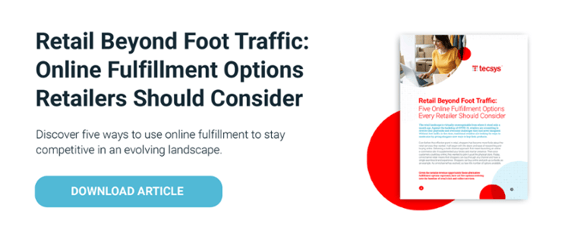Omnichannel Retail vs Pure Play E-commerce

Bain & Company published a powerful newsletter articulating “The Power of Omnichannel Stores.” The research did an excellent job of highlighting the changes gripping the modern retail world. It highlights the importance of omnichannel retail, the growth of e-commerce, and compares the irony of the cross-pollination of these two trends. Ultimately the Bain & Company research, simulations and study recommends a strategy for retailers. That strategy is to be on your toes, invest in the right retail technology, train your associates well, and to not forego omnichannel retail for an e-commerce centric strategy.
Is E-commerce Taking Over The Retail World?
Growth in e-commerce is inevitable. Today, we still see 91% of consumer goods purchased in store. The International Council of Shopping Centers has found this figure to be consistent over the past 2 years. However, the media, research studies, whitepapers, blog posts, and social media commentaries are continually touting the growth and profitability of e-commerce.
To reconcile this, Bain & Company points out that e-commerce and online shopping are growing areas. There is no doubt about this. Bain & Company estimate that 28% of total retail sales will become ecommerce centric by 2030, if the historical trends continue.
Is E-commerce All It’s Cracked Up To Be?
Given the growth of e-commerce, perhaps the smartest choice for a retailer is to shutter the bricks and mortar stores. And shift resources to digital and online, online, online! That’s where Bain & Company points out that a reactionary strategy might seem like the right move, but could cost a company in the long run. For example, they highlight that Amazon’s e-commerce business has just barely been profitable over the past three years. Whereas, bricks and mortar, specialty and even discount stores generally show operating margins of 5% to 11%.
Taking Amazon Head-On
If you are in retail today and have a solid bricks & mortar, physical store presence, is it wise to shift to a highly digitally oriented strategy, as the core? Ultimately, this approach means taking on Amazon in a frontal assault while trying to compete in their area of strength. Why do this risky move instead of focus on your own strengths, instead?
Pure Play E-commerce Moving To Bricks And Mortar?
We have all seen a shift of physical stores to a greater focus on e-commerce. However, the opposite has also been taking place. Pure play e-commerce retailers like Frank & Oak, IndoChino, Ulta, Everlane, Rent the Runway, Bonobos, Canada Goose, ModCloth (before the acquisition), Warby Parker, Glossier, Fabletics, Gilt, Purple Carrot, Athleta, Birch Box, Harry’s, … and even AMAZON – have been opening physical stores. In fact, the Bain & Company report points out that “Amazon is rumored to be rolling out 2,000 stores over the next few years, although the company recently denied this.”
So the question facing retailers is: Should they double down on their digital online business with the intent of stepping away from physical retailing? The alternative is to step up digital, yet leverage the best of physical, to excel at omnichannel retail. In this realm, Amazon is not the 800-pound Gorilla. In fact, this is an area in which most physical retailers have the home advantage.
Economics of Ship-From-Store
The research found that omnichannel retail has a distinct advantage of being able to ship merchandise directly from the store. Furthermore, Bain & Company estimates that this can cut one-day shipping costs by up to 50% – for retailers. Beyond that, offering shoppers click and collect services (not currently an Amazon strength), would drop shipping costs to ZERO! Better yet, our estimate is that 58% of shoppers doing a pickup end up purchasing additional items. Capitalizing on click and collect services can definitely become your winning advantage.
If that wasn’t enough, an Aberdeen study (via OneReach.com) found that retailers using omnichannel engagement retain an average of 89% of their customers. An even more telling aspect of the study was that 56% of shoppers fail to return to a retailer which does NOT have an omnichannel retail strategy.
Omnichannel Retail Case Study
Elegantly, the Bain & Company study builds out a 10 year business case contrasting two different retail approaches articulate above. One, they term the ‘Siloed Sales’ retail, which opts to refocus resources on a highly digital and e-commerce centric approach. In doing so, it shutters 400 physical stores, invests heavily in e-commerce technology, vastly expands its product offering, opens multiple distribution / fulfillment centers, and takes on Amazon head-on. Second is the ‘Omnichannel Emporium’ example. They invest heavily in retail technology, maintain their branded and white labeled product offering, close 400 non-performing locations, maintain only one distribution center, and open 400 new locations.
Bain & Company’s simulations and case show that the second omnichannel oriented retailing model, wins out in various respects. Their analysis spans 10 years, but the brand erosion of the first case points to a downward spiraling business.
Omnichannel Retail – Leverage Your Strength
Kudos to Aaron Cheris, Darrel Rigby and Suzanne Tager, for jointly writing the 2016-2017 newsletter. It looks at the market trends that points to an intuitive conclusion, which on further reflection – is not the clearly correct one. Yes, there will be continued growth in the online e-commerce business model. Moreover, all retailers need to embrace the digital online world.
However, the smart approach is to leverage your strengths, take on digital technologies, and do so to drive your omnichannel retail model. Failing to do so, is a risk that most retailers need to avoid.
